
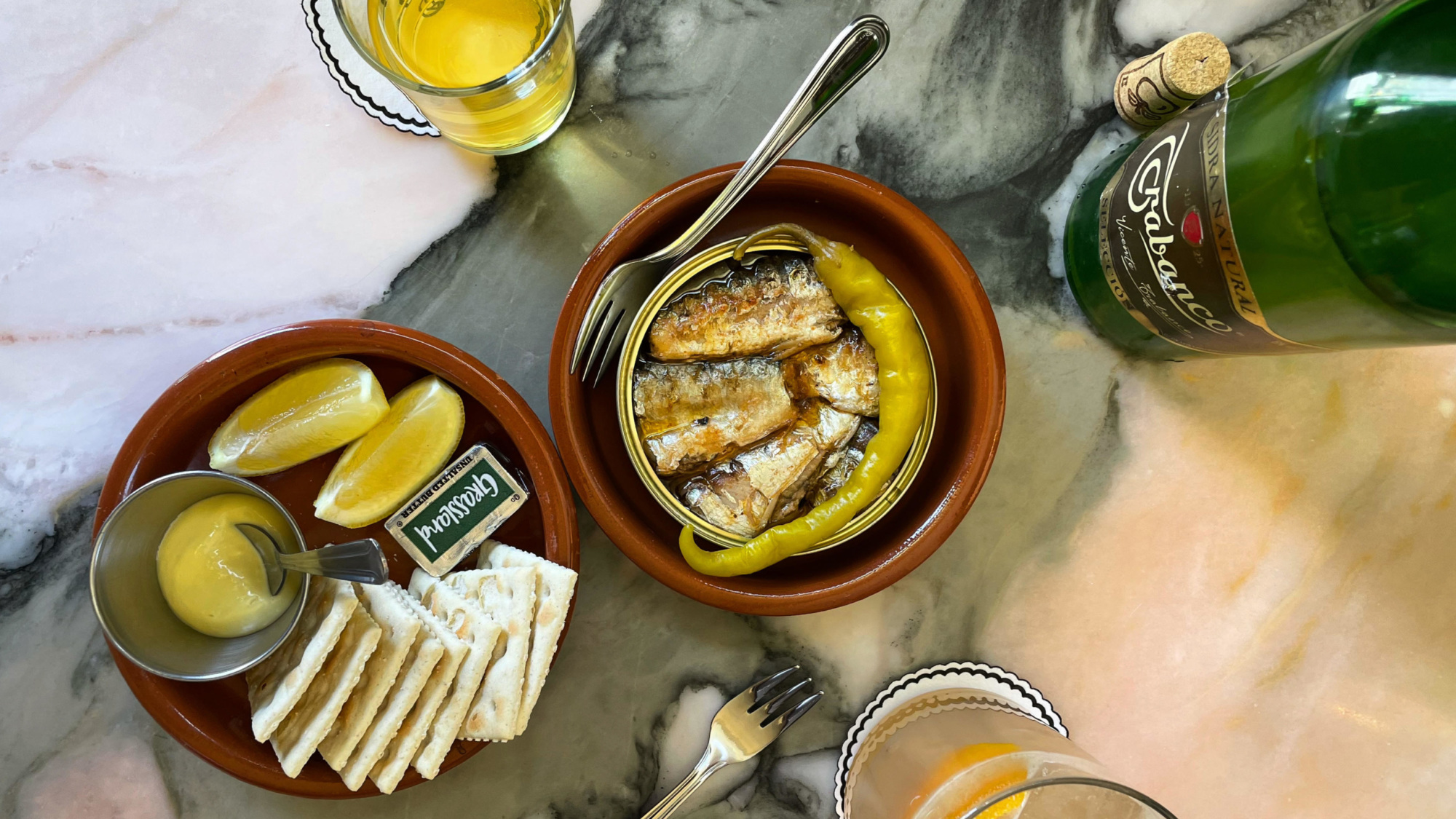
Tinned fish is having a moment — and we don’t mean your average can of supermarket tuna. Premium canned seafood, from sardines and anchovies to mussels and yes, even tuna, are finally getting their due here in the States.
Conservas, as they are called in Spain and Portugal, are often produced by small canneries that preserve the region’s super fresh seafood right after it’s harvested. Salty, savory, and umami, not to mention hearty and nutritious, they’re often packed with high-quality olive oil, tomato, spices, and more.
The cultural perception of tinned seafood as cheap survival food has dominated in the U.S. over the past century, but that’s changed as thought leaders in the food space “started advocating for the deliciousness, elegance, convenience, and utility starting in the late aughts,” says Becca Millstein, co-founder and CEO of Fishwife, a tinned seafood company based out of Los Angeles, Calif., whose conservas are also served in a number of restaurants across the country.
Millstein thinks conservas will continue to take off as more Americans travel to Southern Europe, and get even more into its perfect complement: natural wine. The need for shelf-stable food and creative meals at home at the onset of the pandemic, too, gave tinned fish a boon, she points out.
Sure, you could crack open a tin and a bottle of wine at home. But doesn’t it sound great to enjoy conservas with a dry cider, smoky cocktail, or crisp rosé at a restaurant? Of course it does. That’s why we asked chefs, food and beverage directors, and restaurant owners for their perfect conservas-and-drink combinations.
El Pingüino
Grilled Sardines Escabeche
It’s only right that Spanish seafood bar El Pingüino has an entire conservas section on its menu. There are mussels, octopus, and squid in various briny and tomato-y sauces, but the sardines in escabeche are most popular says owner Nick Padilla.
What sets these sardines apart? They’re from Güeyu Mar, a restaurant in Asturias, along Spain’s northwest coastline, that produces its own line of conservas. Another game changer, says Padilla, is that Güeyu Mar “chargrills all the seafood before canning, so the wood smoke really comes through, and the seafood is top quality. I like the sardine on a saltine with aioli and lemon, and the escabeche marinade” — a pickling method using vinegar — “left in the can is an incredible bread dip.”
Nick’s recommended drink pairing:
“My personal favorite pairing is a bottle of cider from Asturias. We serve a 700 ml bottle of Trabanco, a very traditional producer from Gijon. A tin of the grilled sardines and a bottle of Trabanco is a perfect light meal for one, maybe with some cheese after the sardines.
If you want a cocktail, we make a drink called an El Picador that’s made with Unión mezcal, allspice dram, and lime. It’s a slightly smoky, spiced version of a margarita. The acidity of the El Picador is great with the fatty, rich sardines. Also, since the sardines are grilled and canned in an escabeche sauce, they can stand up to the stronger smokier flavors in the cocktail.”
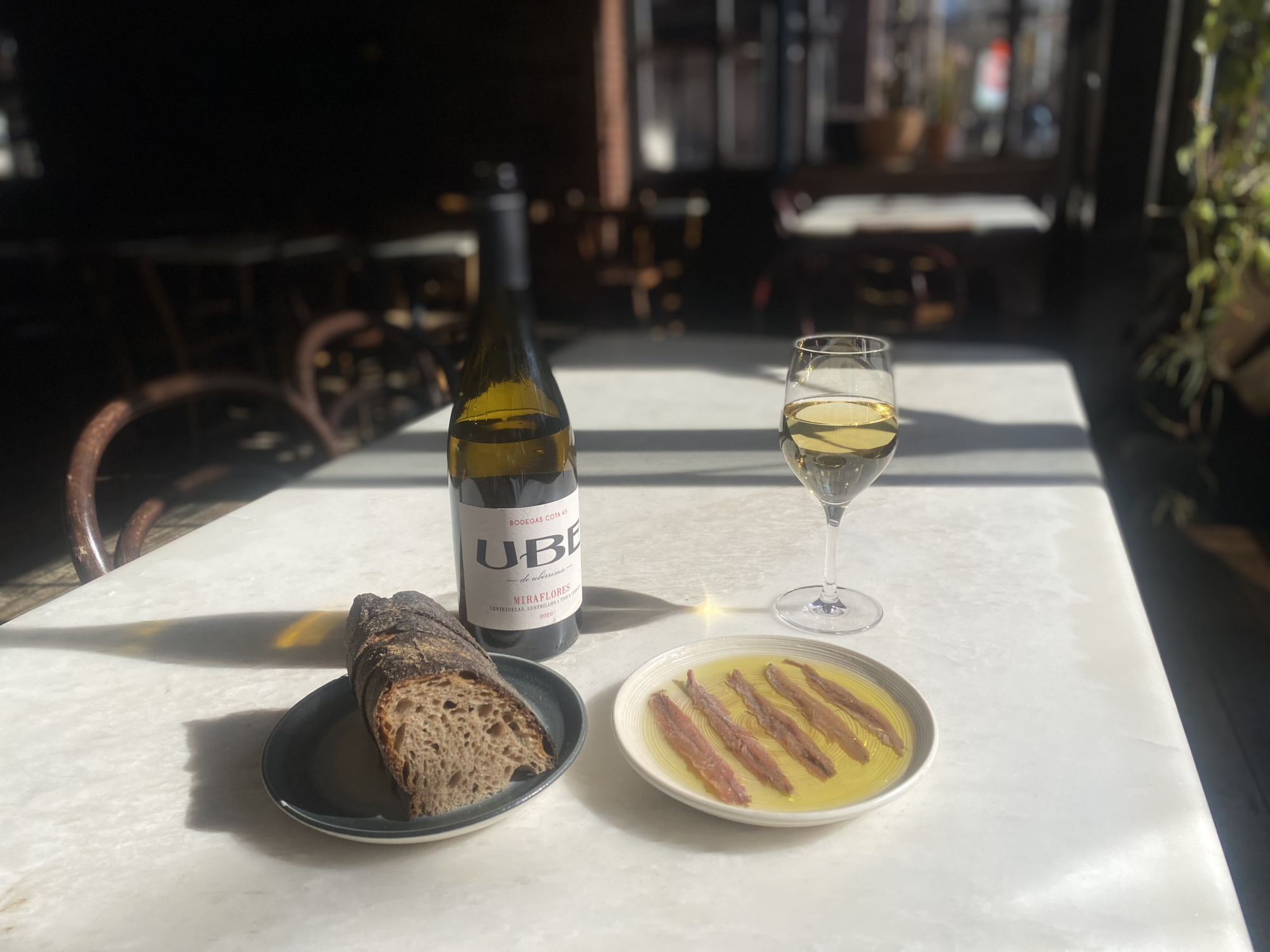
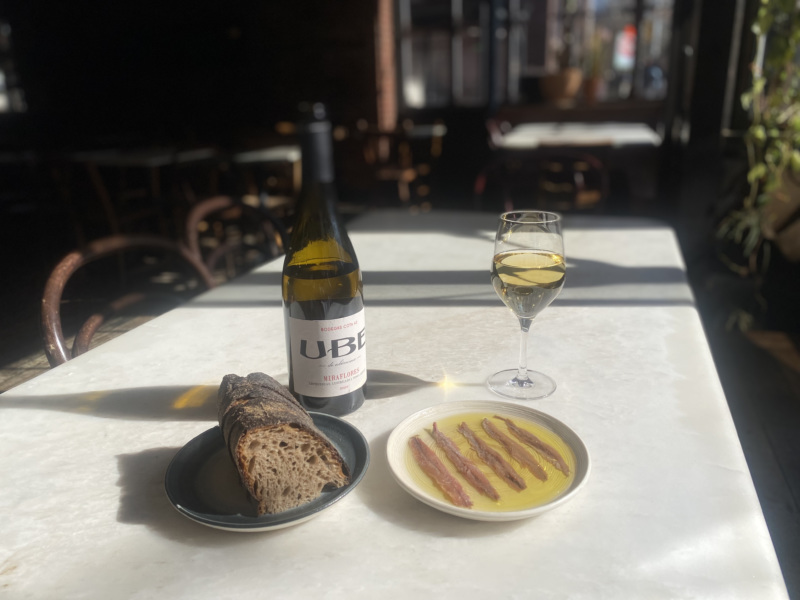
Rhodora Wine Bar
Sardinian Anchovies
Not only do cured anchovies taste like “pure umami,” as food director Josh Even puts it, but their recyclable vessel also fits with this natural wine bar’s zero-waste mission.
That doesn’t mean the tin’s contents skimp on flavor and texture, though. Even describes Rhodora’s anchovies as “thin, but fatty, and the best anchovies.” They are imported from the Italian island of Sardinia, and also just “a bit stiff with just a little crunch from the salt. They are coated in oil without being oily, and with a bit of butter or aioli on warm bread, I cannot imagine a more satisfying and umami-ful little bite,” he adds.
Calla and Josh’s recommended drink pairing:
“Sherry and tinned seafood go hand in hand,” Even notes, and Rhodora’s beverage director Calla Camero agrees.
“I find that sherries, in most ways, are anchovies’ best beverage pairing,” Camero says. “I like a dry sherry with some oxidation. Something that might be a bit raisiny on the front end but still finish bright and clean, maybe an Amontillado or Palo Cortado. We don’t serve sherry at Rhodora, largely because it’s very rarely made naturally. So for me, Cota 45’s UBE Miraflores, a white wine, plays the role perfectly for the Sardinian anchovies. Made from 80- to 90-year-old Palomino vines planted at 50 to 60 meters above sea level, facing west on three different types of Albariza soils, UBE Miraflores is a great expression of how Palomino can shine without fortification; it has a beautiful big body with medium acidity, a fresh bouquet of pears and honey, lemongrass, sherbet, and guava, followed by a lengthy and herbal finish. What more can I say about sherry and anchovies, except that, there are good pairs and then there are soulmates.”
Saint Julivert Fisherie
Cantabrian Anchovies
“Our anchovy set at Saint Julivert Fisherie has been a signature from day one. We use mostly Basque anchovies,” says chef and co-founder Alex Raij, who also co-authored a cookbook on food from that region of Spain. “The current spring iteration is among our favorites — it includes aged beet butter, and pickled things.”
Alex’s recommended drink pairing:
“Our Kampai Martini is always a win, but this spring our pairing of choice is the 2020 Ekato Rosé of Moschofilero from Troupis Winery. This Greek rosé has remarkable tea rose notes that are great with the beet and anchovies. The wine also has enough texture to handle our house sourdough.”
Another “win for the tin,” as she puts it, is Saint Julivert’s Violet Hour from 5 to 6:30 p.m., during which all rosés are $10 off.

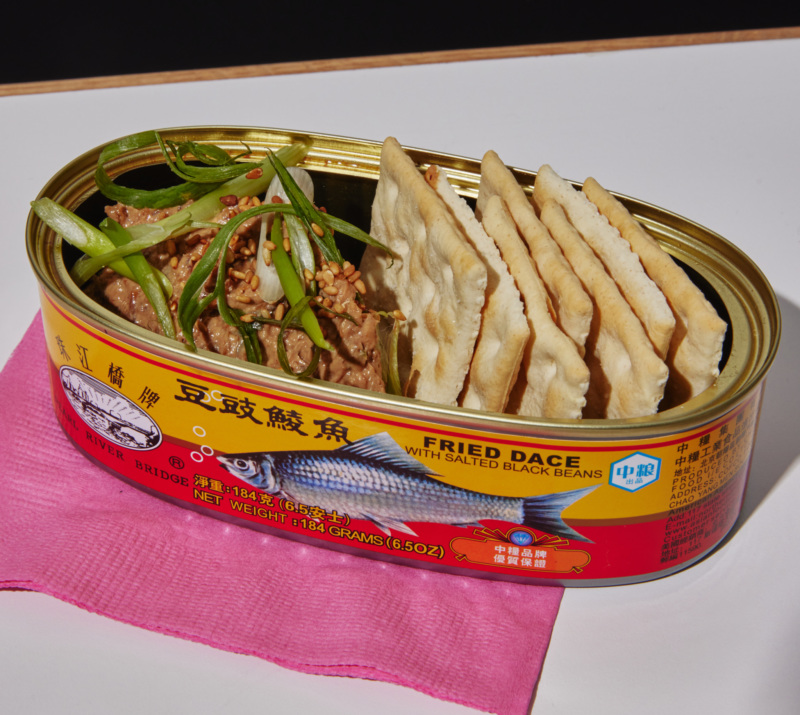
Bonnie’s
Tinned Dace Dip
Europe does not have a monopoly on tasty tinned fish. At Bonnie’s in Williamsburg, Brooklyn, where chef and owner Calvin Eng blends his Brooklyn upbringing with his Cantonese heritage, you’ll find canned dace (in the carp family) on the menu.
“Tinned dace fish is a pantry staple in a Cantonese household,” he says. “Its savory flavors from the addition of fermented black soybeans make it extremely addicting and satisfying. I’ve eaten this as is, right out of the can over a bowl of rice numerous times throughout my life. The can shape itself is iconic, which is why we chose to serve our dip right out of the can,” and with some saltines for good measure.
Calvin’s recommended drink pairing:
Since the dace is “such a savory umami bomb that is served cold, I find that it pairs well with bubbles, like in our Ribina Highball” made with mezcal. “The highball is a great pairing because of the light effervescence that makes them crushable thirst quenchers when paired with something so heavily savory. Ribina is a black currant drink that is an iconic beverage that’s popular in Hong Kong.”
La Vara
Bonito en Conserva; Anchovies
At La Vara, Saint Julivert’s sister restaurant, Raij and co-chef and co-owner Eder Montero explore Spain’s Moorish and Jewish heritage.
Here, too, you’ll find anchovies, typically from the Cantabria region of Spain, and paired with dukkah butter and charred sourdough. “Each application and inspiration [of conservas] dictates the brand, size, and format of the loins,” Raij notes.
La Vara’s Bonito en Conserva is a riff on a dish in “The Basque Book” which, in turn, came from recipes from the kitchen of Txikito, Raij and Montero’s Basque restaurant which is reopening this spring. “Here, we marry smoked eggplant with oil-cured albacore,” usually pole-caught Bonito del Norte, “and an herb salad,” she explains.
Alex’s recommended drink pairing:
“Our favorite pairing right now is the 2019 Pormenor Duoro Branco Reserva,” a Portuguese white wine. “The Pormenor Reserva is a beautifully made wine of Rabigato and Codega that embraces both the smokiness of the eggplants and the rich oiliness of the fish in a way that enhances both the wine and the dish.
If you prefer a cocktail, Raij recommends La Vara’s Colibrini, with gin, Manzanilla sherry, vermut, and strega, with an olive and a twist. “This is a lightly herbal martini, stirred with Manzanilla sherry, which offers dry nutty notes and a welcome briny balance that pairs beautifully with Bonito en Conserva.”
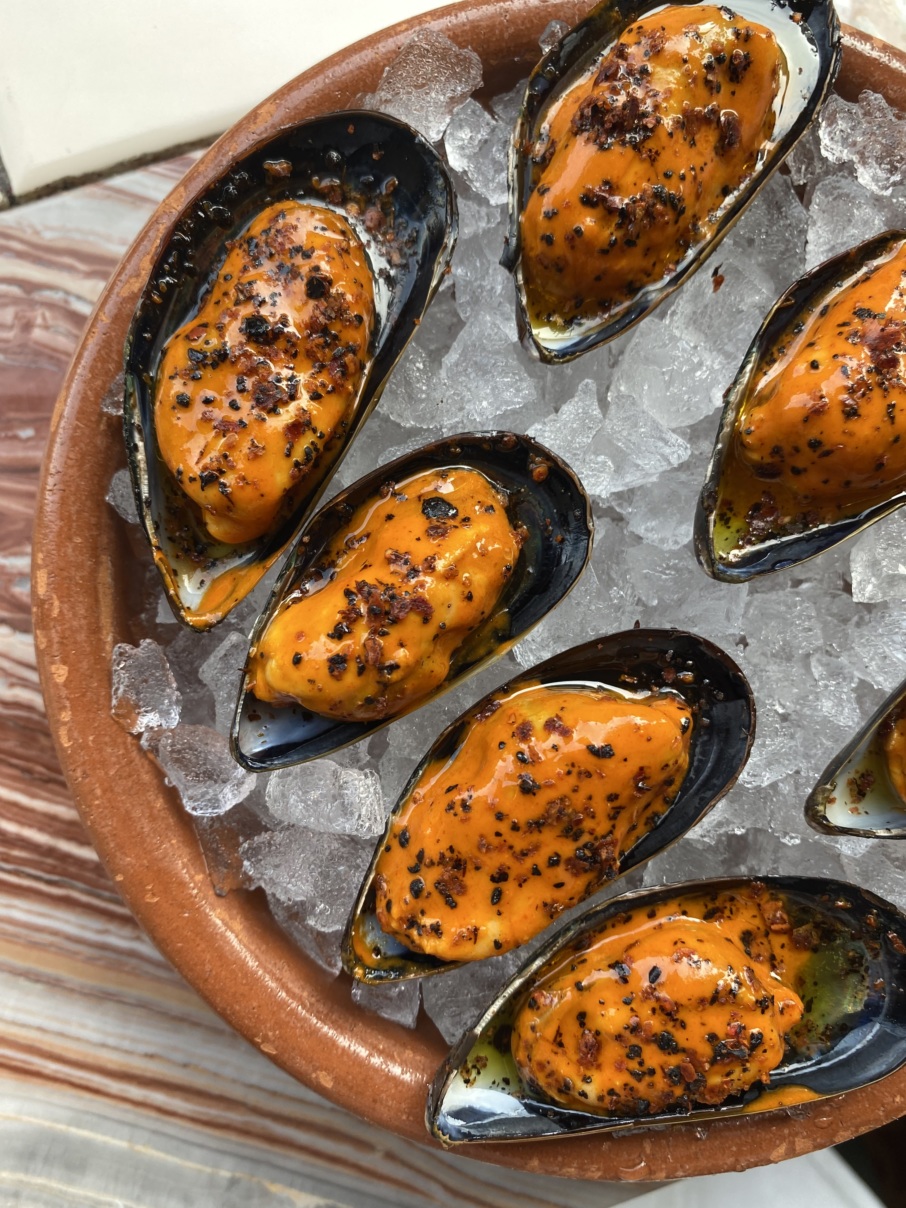
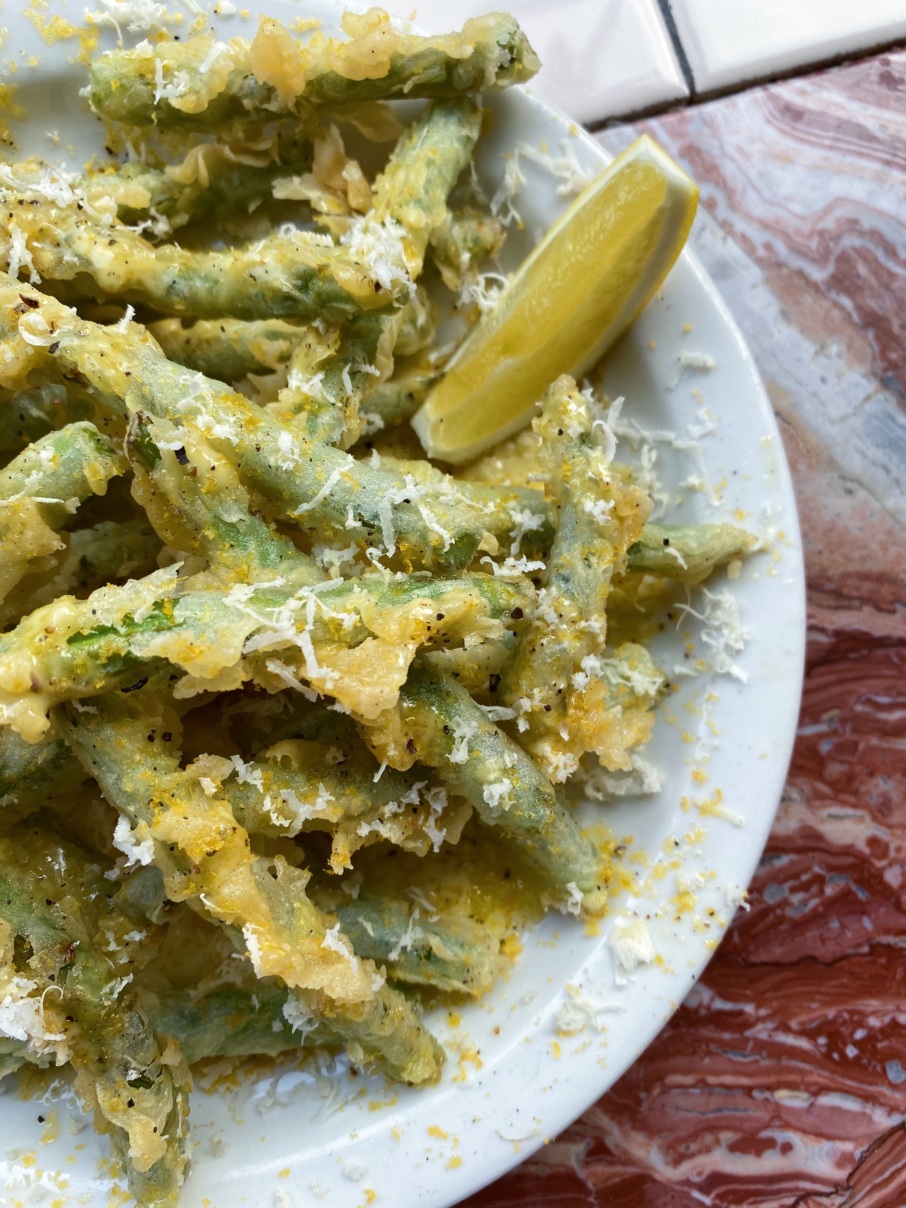
Cervo’s
Spicy Mussels Escabeche; Fried Green Beans
At this Portuguese- and- Spanish-inspired restaurant and oyster bar, seafood and natural wines are the focus.
Also a focus for the team behind Cervo’s (which is also behind Brooklyn’s Hart’s and The Fly) is conservas. In January, they launched Minnow, a tinned seafood brand. Including not only Spanish sardines but also Icelandic cod liver and Alaskan salmon; the line is available for purchase at Cervo’s.
On the menu at Cervo’s is a mussels escabeche dish. “These are an ode to mussels escabeche found in tins in Spain. We steam the mussels in Basque cider, pull them from the shell and marinate them in a sauce made from the steaming liqueur, chili and paprika,” explains partner Nialls Fallon.
Canned anchovies make an appearance in the fried green beans with anchovy dressing and bottarga, too. “This is our version of the Portuguese dish, Peixinhos da Horta, which translates roughly to ‘little fish from the garden,’” says Fallon. “We use canned anchovies to make a creamy vinaigrette that goes over the battered and fried green beans, and then bottarga and horseradish is shaved over the top.”
Taylor’s recommended drink pairing:
“My preferred wines to enjoy with conservas, ours and others, are often from coastal regions,” says Taylor Ward, wine and service director for Cervo’s, Hart’s, and The Fly. “Albariño from the Rias Baixas, the western most appellation, or wine region in Spain, is an obvious choice for pairing. Especially those made by Alberto Nanclares and Silvio Prieto, who reside in the small seaside village of Cambados — it’s also home to one of my favorite canneries. The Nanclares y Prieto albariños capture the briny ocean influence and are the dictionary definition of minerality of the Rias Baixas. Their Dandelion cuvee is softer and generous with notes of over ripened orchard fruit, an ideal match for Cervo’s spicy mussels escabeche. The A Grana and Tempus Vivendi cuvees are sharp and lean — best in an ice bucket next to some Minnow sardines with a baguette, parsley, and butter.”
Sophia Gottfried is a writer based in New Jersey. You can follow her on Instagram. Follow Resy, too.
Discover More

Stephen Satterfield's Corner Table





















